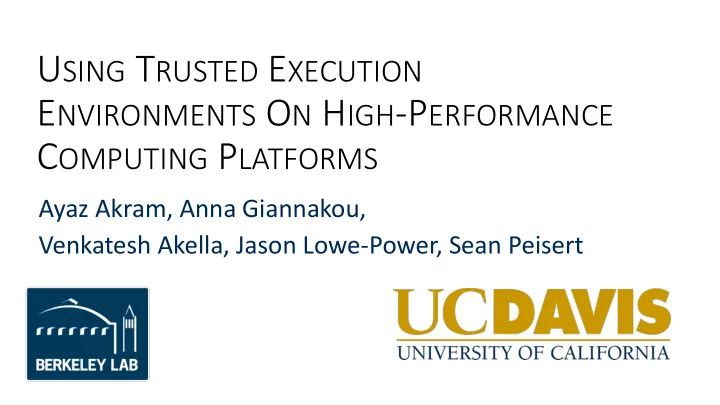

U SING T RUSTED E XECUTION E NVIRONMENTS O N H IGH -P ERFORMANCE C OMPUTING P LATFORMS Ayaz Akram, Anna Giannakou, Venkatesh Akella, Jason Lowe-Power, Sean Peisert
Secure High-Performance Computing How to compute with large sensitive data? Biomedical data Proprietary data Secure from both external and internal threats Integrity or confidentiality or both 2
High-Performance Computing Workloads Common characteristics Large data sets (10s – 100s GB per node) Limited user interaction (batch) Often highly multithreaded Dedicated (super computers) or shared (cloud) nodes Diverse compute, memory, and security requirements 3
We Analyze Two TEEs [1] [1] Technology Ensures TCB Size Secure Memory Size Application Integrity Changes Intel SGX Yes Small 128 MB (useable: 94MB) Required AMD SEV No Large Up to RAM size Not Required 4 [1] Christian Göttel et al. "Security, performance and energy trade-offs of hardware-assisted memory protection mechanisms." IEEE Symposium on Reliable Distributed Systems (SRDS), 2018.
Methodology • Benchmarks used: NAS parallel benchmarks, LightGBM and GAPBS • Platforms used: Intel Core i7-8700 (12 threads/socket) for SGX and AMD EPYC 7451 (dual socket with 48 threads/socket) for SEV study • Use of SCONE (SGX) and Kata (SEV) containers • Measured slowdown of the used workloads under secure execution on both platforms • Relate the slowdown to other collected metrics 5
Performance Impact of SGX High slowdown, especially for graph workloads 100 145 NPB (Class C) GAPBS (synth) GAPBS (road) LGBM (mslr) 6
Enclave Page Cache (EPC) Faults NPB (Class C) GAPBS (synth) GAPBS (road) LGBM (mslr) 360 500 7
Enclave Page Cache (EPC) Faults All the benchmarks have large resident memory except ep & tc_synth 8
Impact of Increasing Execution Threads (under SGX) Don't scale well, as they have large resident memory 9
Impact of Increasing Execution Threads (under SGX) Scales normally under SGX and has a small memory footprint 10
Performance Impact of SEV NPB (Class C) GAPBS (synth) GAPBS (road) LGBM (mslr) 11
Performance Impact of SEV Virtualization appears to be the biggest reason of slowdown 12
Preliminary Takeaways Future TEEs should support HPC apps Smaller slowdowns for SEV Performance issues for SGX EPC faults Multiple execution threads SEV and SGX slowdowns Dynamic choice of threat model 13
Recommend
More recommend